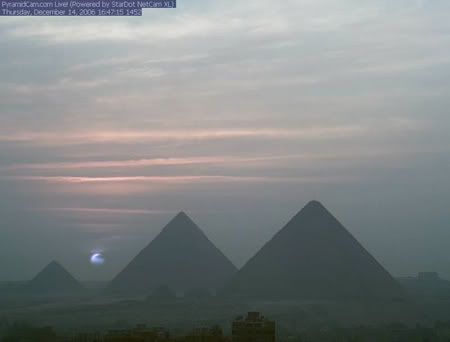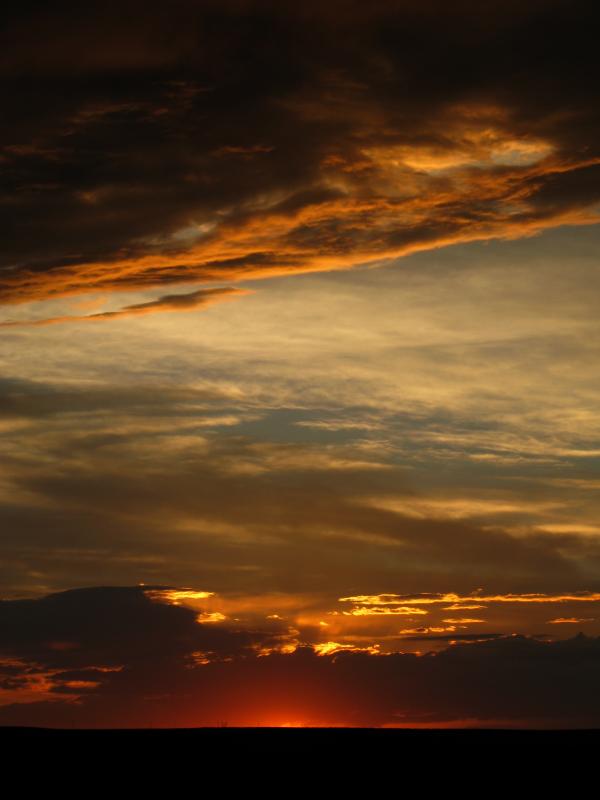Get Email Updates • Email this Topic • Print this Page
No other light goes red from passing through the Earth's atmosphere, so why should the moon's?
...it is the scattering of the blue light waves that makes the daytime sky appear blue - if it weren't for the blue scattering, the daytime sky would look just like the nighttime sky (with the exception of one big honkin' star!) ...
the redness of sunsets
A) then why are not all sunsets red?
B) and where does the green light go?
C) and why is the sky not violet, if its the shorter wavelengths that are scattered?
The intensity I of light scattered by a single small particle from a beam of unpolarized light of wavelength λ and intensity I0 is given by:
D) and is there an experiment we can do to prove this?
E) and did you notice that the colour of the sky is the opposite exactly of the sun?
F) and if you did, then why is that not noted in any of the Rayleigh theory?
Rayleigh scattering causes the blue hue of the daytime sky and the reddening of the sun at sunset.

Poseidon wrote:B) and where does the green light go?
C) and why is the sky not violet, if its the shorter wavelengths that are scattered?
... sounds like a question for a mathematician:
Quote:
The intensity I of light scattered by a single small particle from a beam of unpolarized light of wavelength λ and intensity I0 is given by:
G) and why is this red light not visible when we look at the dark side of the earth from space?
H) and why do you keep avoiding question (G) ?
As Pete Conrad, **** Gordon, and I were speeding toward Earth in our command module, we were treated to a marvelous sight never before seen by any humans. We were seeing our home planet Earth eclipse our own star, the Sun. As we were about 27,000 nautical miles out, the Earth moved to completely obscure the disk of the Sun. I reported to mission control "...the atmosphere is illuminated completely around the Earth..." Pete added, "It has blues and pinks in it, but instead of being banded, it's segmented. I don't know why."
It was hard to see the dark Earth at first, but as our eyes adjusted, we could see we were over the Indian Ocean just off the eastern most tip of Africa moving very fast, almost 25,000 miles per hour. And right down in the center of the disk of the Earth was a bright round light. It seemed to move rapidly across the clouds and water. What it was we didn't know. Only later would astronaut Rusty Schweickart tell us that strange bright moving light was a reflection of the same full moon, which was directly behind us, we had walked on only four days ago.


... I'm not sure I follow ... the setting sun is red - the sky is blue ... red is on the opposite side of the visible spectrum from blue ... the point is?

A colorless substance reflects a color the opposite of that of the light that it is in.
Although this seems to be a digression, I am pointing out the error in Rayleigh scattering, is that it presuposses a white sun. He considers the sun to appear gold, but actually be white.
my original notion still holds: If the sun's light was scattered in the manner described by Rayleigh, then ALL sunsets would be red. Whereas, most are actually not red. Only in smoggy skies, or partially dusty skies are they thus.
I also find it very hard to believe that the Earth would be surrounded by a red halo when viewed from space. It seems to me that this red light would still be seen from orbit.
I would suggest that during the lunar eclipse, from the vantage point of the Moon, the entire sky would appear red, and the Earth would appear green.
Poseidon, you mentioned red dwarf stars in an earier post. If I am correct, these are "M" class stars. How could they ever produce enough light to cause the red color we see during a lunar eclipse?


because of the shape of the moon/
the geometry of this diagram.
the red light is consentrated by the shape of the moon.
also, the doppler effect could be playing a significant role. (red shift of all distant objects)
and,
the same way that a candle at night can be seen from a large distance away, whereas during the day it is overpowered by the sun's light.
its still a type G star: yellow
Our Sun itself is white. It is sometimes called a yellow star (spectroscopically, relative to Vega), and may appear yellow or red (viewed through the atmosphere), or appear white (viewed when too bright for the eye to see any color). Astronomy images often use a variety of exaggerated colors (partially founded in faint light conditions observations, partially in conventions). But the Sun's own intrinsic color is white (aside from sunspots), with no trace of color, and closely approximates a black body of 5780 K (see color temperature). This is a natural consequence of the evolution of our optical senses: the response curve that maximizes the overall efficiency against solar illumination will by definition perceive the Sun as white. The sun is known as a G type star.
living at the coast, many sunsets are not red
because of the doppler effect
because the red light is not concentrated by the shape of the moon.
not green because there is no red light to be opposite to (as per the experiments mentioned)
As for the opposite color experiments, yes, and easy to prove.

As for where the red light originates from, not that i can think of immediately, but if we cannot see the red light coming from the earth's atmosphere, then where else is it coming from? Only 2 possibilities : Red dwarfs and/or the Doppler effect.
from some quick web searches i have done, it does actually have a feint blue tinge, in opposition to the feint yellow colour of the full moon
2 possibilities
a) the sun's corona is strong enough to overpower this effect
b) i have not seen a full solar eclipse, but i seem to remember a red hue from the partial one, but that was at least a decade ago so not too sure.
One more point about the sunset issue:
At sunset, the sun is still visible, during a lunar eclipse it is not!
If the suns light was being bent around the earth, (as in refraction)
we would get a red glow after the sun has set.
But we do not.
...



...also, the doppler effect could be playing a significant role. (red shift of all distant objects)
